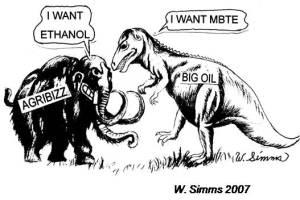Appeared in San Fernando Valley Sierra Club newsletter in July 2007.
What Smells About Ethanol Fuel
Sarah S. Mosko, Ph.D.

Pick your poison — ethanol pollutes the air and MBTE pollutes underground water. Illustration by Willis Simms.
From President Bush on down, it seems everyone is talking up “biofuels”, especially corn-grain ethanol, as the panacea to the country’s energy woes… global warming, air pollution, increasing prices at the pump and dependence on foreign oil.
Automakers are promoting flex-fuel cars that run on either E85, a gasoline mixture that is 85% ethanol, or straight gasoline. Agribusiness giants like Cargill and Archer Daniels Midland are trumpeting their ethanol, fermented and distilled from corn, as they boost production to meet rising domestic demand. However, just because a fuel can be made from plants does not make it inherently “green” or ever plentiful enough to replace gasoline.
A reputable analysis concluded that conversion of all U.S. cropland to produce corn strictly for ethanol would not suffice to fuel the current fleet of American autos.1
Pluses to Ethanol
Indisputably, there are some pluses to ethanol. It is renewable and can be produced domestically. Conversion of gasoline cars to flex-fuel vehicles is relatively inexpensive. Compared to gasoline, emissions of greenhouse gases are reduced somewhere between 10% and 30%. Whether other problem emissions are reduced, including carbon monoxide, acid-rain causing sulfur dioxide, VOCs (volatile organic chemicals) and inhalable particulates, apparently varies with how much ethanol is blended in with gasoline and is the subject of controversy
Ethanol Drawbacks
- Production of ethanol is heavily dependent on fossil fuels: Modern corn farming uses copious amounts of inorganic fertilizers and pesticides manufactured from natural gas or oil. Fossil fuels also provide the energy to drive irrigation, to manufacture and operate field machinery, to distill fermented corn into ethanol and to provide transportation from points of manufacture to neighborhood gas stations.
- Poor energy efficiency: The production of ethanol is so energy intensive that the energy contained in ethanol is, at best, just bit more than the fossil fuel energy that went into making it.
- Cost at the pump: Compared to gasoline, ethanol supplies 30% less energy, which means poorer fuel economy and more frequent trips to gas up.
- Hidden taxpayer-supported corn subsidies: Uncle Sam shells out $4 billion/yr to subsidize domestic ethanol production, much of it going to agribusiness cartels. Gallon for gallon, this subsidy is 45 times the subsidy for gasoline.1
- Smog: Adding ethanol to gasoline can increase smog, especially in summer months.
- Availability: Far fewer than 1 in 100 gas stations nationwide provide E85. As of late 2006, CA had only three. Major car manufacturers, however, have put many E85-capable vehicles on the road to profit from a federal law that allows them to take mileage credits for such cars toward meeting the CAFE requirements, even though those vehicles’ gas mileage might be very poor. (Note: E85 must be distinguished from the small amounts of ethanol currently blended into all gas sold in CA to replace MTBE, the toxic octane booster that was found to be contaminating drinking water).
- Environmental impacts: Applying industrial farming methods to grow massive amounts of corn certainly would accelerate soil contamination, erosion, and groundwater depletion. Heavy use of fertilizers could foster oxygen-depleting algal blooms and dead zones in fresh and marine bodies of water that are downstream of the agricultural run-off.
- Expansion of a corn “monoculture”: Corn agribusiness giants generally rely on genetically-modified seed lines supported by liberal application of pesticides/herbicides. The result is a distorted ecosystem lacking in normal biodiversity – naturally occurring insects and the birds that feed on them are suppressed. Already, much of Iowa’s corn-belt can be characterized as such a monoculture.
- A question of morality: Historically, the US has been an exporter of grains on which countless peoples around the globe depend for basic survival. Americans of conscience question the morality of diverting cropland to fuel U.S. transportation when so much of the world goes hungry.
- Higher prices for food stuffs: Some vegetable farmers in CA are switching to corn to cash in on the profits. The upshot could well be higher prices for fresh or processed vegetable products as yields shrink. Meat prices could jump too as corn-fed livestock become costlier to raise.
A Change of Mindset
With all these downsides, it is hard to see what’s driving all the fanfare around ethanol fuel, except perhaps the obvious corporate profit motive. We need to start thinking outside the box and realize that maybe we do not really need to gas up with anything. Why not divert corn and fossil fuel subsidies to support the expansion of highly energy efficient and renewable solar and wind energy enterprises that, in combination with electric-powered vehicles, would mean that we never visit the gas pump at all. No new technology is needed. Just a change of mind set.’
To participate in a California-based statewide plastics reduction campaign, contact Earth Resource Foundation or call (949) 645-5163.
(1) R. Heinberg, 2006. The Party’s Over: Oil, War and the Fate of Industrialized Societies. New Society Publ., BC, Canada.
(2) D. Pimentel et al, 2007. Ethanol production: energy, economic, and environmental losses. Rev Environ Contam Toxicol 189:25-41.